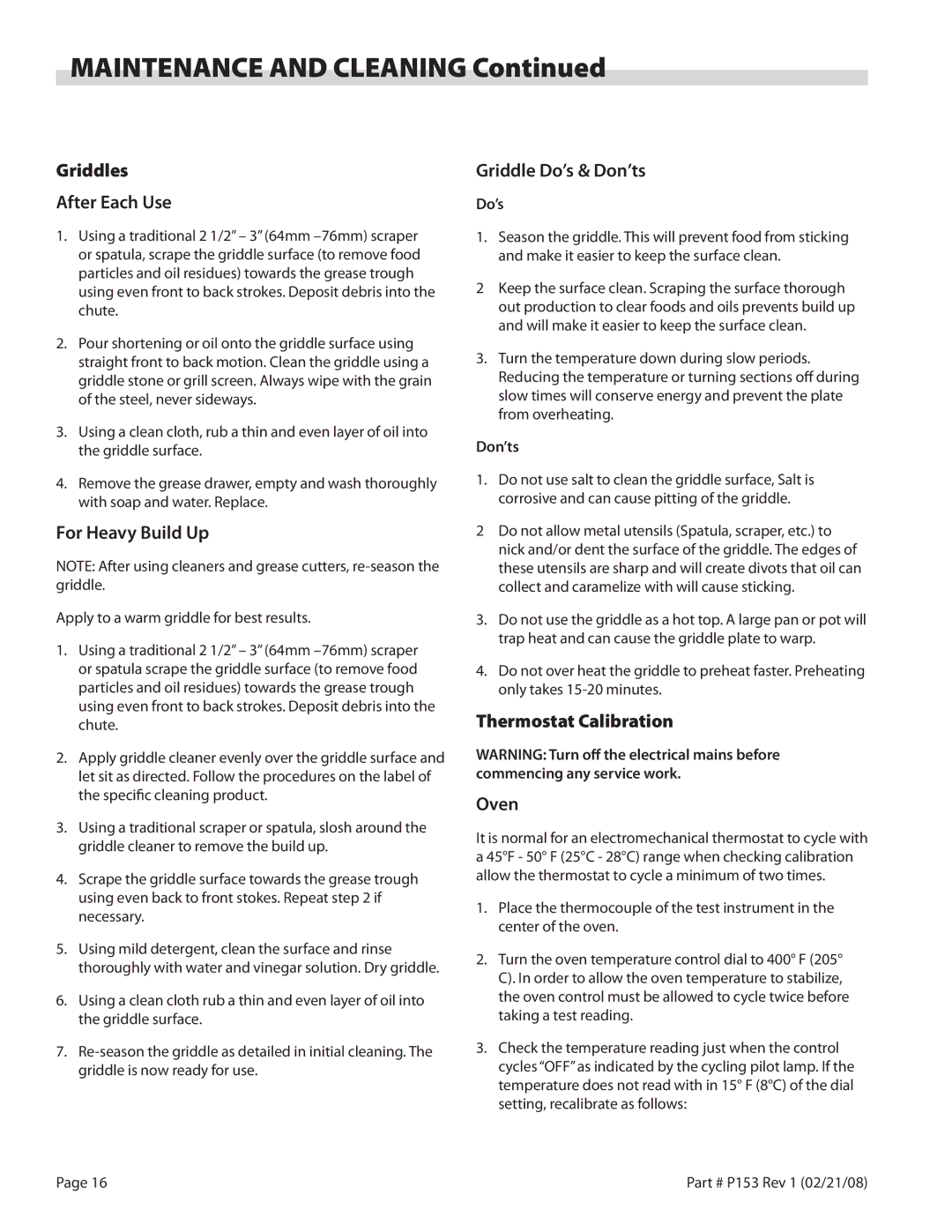MAINTENANCE AND CLEANING Continued
Griddles
After Each Use
1.Using a traditional 2 1/2” – 3” (64mm
2.Pour shortening or oil onto the griddle surface using straight front to back motion.. Clean the griddle using a griddle stone or grill screen.. Always wipe with the grain of the steel, never sideways..
3.Using a clean cloth, rub a thin and even layer of oil into the griddle surface..
4.Remove the grease drawer, empty and wash thoroughly with soap and water.. Replace..
For Heavy Build Up
NOTE: After using cleaners and grease cutters,
Apply to a warm griddle for best results..
1.Using a traditional 2 1/2” – 3” (64mm
2.Apply griddle cleaner evenly over the griddle surface and let sit as directed.. Follow the procedures on the label of the specific cleaning product..
3.Using a traditional scraper or spatula, slosh around the griddle cleaner to remove the build up..
4.Scrape the griddle surface towards the grease trough using even back to front stokes.. Repeat step 2 if necessary..
5.Using mild detergent, clean the surface and rinse thoroughly with water and vinegar solution.. Dry griddle..
6.Using a clean cloth rub a thin and even layer of oil into the griddle surface..
7.
Griddle Do’s & Don’ts
Do’s
1.Season the griddle.. This will prevent food from sticking and make it easier to keep the surface clean..
2Keep the surface clean.. Scraping the surface thorough out production to clear foods and oils prevents build up and will make it easier to keep the surface clean..
3.Turn the temperature down during slow periods.. Reducing the temperature or turning sections off during slow times will conserve energy and prevent the plate from overheating..
Don’ts
1.Do not use salt to clean the griddle surface, Salt is corrosive and can cause pitting of the griddle..
2Do not allow metal utensils (Spatula, scraper, etc..) to nick and/or dent the surface of the griddle.. The edges of these utensils are sharp and will create divots that oil can collect and caramelize with will cause sticking..
3.Do not use the griddle as a hot top.. A large pan or pot will trap heat and can cause the griddle plate to warp..
4.Do not over heat the griddle to preheat faster.. Preheating only takes
Thermostat Calibration
WARNING: Turn off the electrical mains before commencing any service work..
Oven
It is normal for an electromechanical thermostat to cycle with a 45°F - 50° F (25°C - 28°C) range when checking calibration allow the thermostat to cycle a minimum of two times..
1.Place the thermocouple of the test instrument in the center of the oven..
2.Turn the oven temperature control dial to 400° F (205° C).. In order to allow the oven temperature to stabilize, the oven control must be allowed to cycle twice before taking a test reading..
3.Check the temperature reading just when the control cycles “OFF” as indicated by the cycling pilot lamp.. If the temperature does not read with in 15° F (8°C) of the dial setting, recalibrate as follows:
Page 16 | Part # P153 Rev 1 (02/21/08) |
